With its iconic K20 engine and great handling straight out of the box, tuning the Honda Civic Type R EP3 is a dream. We show you the best way to extract all of that un-tapped potential to turn your Civic into a supercar slayer.
As one of the best-known hot hatch heroes, there’s a whole smorgasbord of Honda Civic Type R EP3 tuning products, but which ones should you choose? To guide you through the minefield and ensure you come out with the best possible result, we’ve broken the car into its component parts to give you specific advice on how to maximize each area when tuning your car.
We’ll show you which parts you’ll want to upgrade – as well as which ones work fine from the factory – to let you know the essential areas to spend your cash to get the very best from what is an extremely capable car.
Honda Civic Type R EP3 History
As the first official Civic Type R to come to UK shores, Honda decided to build its new hot hatch close to its latest target market. So, in 2001, the car’s production began in… Swindon in the UK. Still, the lack of perceived JDM mystique didn’t do the EP3’s sales figures any harm, as it went on to become one of the best-selling hot hatches of all time.
Boasting a headline grabbing 100bhp per litre from its screaming 2.0-litre VTEC engine, plus a slick-shifting six speed ‘box and an agile chassis to exploit all that high-revving power, the model quickly established itself as the benchmark hot hatch for a whole generation of performance car enthusiasts, and has become one of the most popular rides to modify and tune.
Over the years, just about every tuning method you can think of has been successfully applied to the Honda Civic Type R EP3, from throttle bodied 9000rpm track monsters, to turbocharged 1000bhp drag queens, so the world really is your oyster when it comes to building your dream EP3 Civic Type R, the only hard part is deciding which route you’re going to choose!
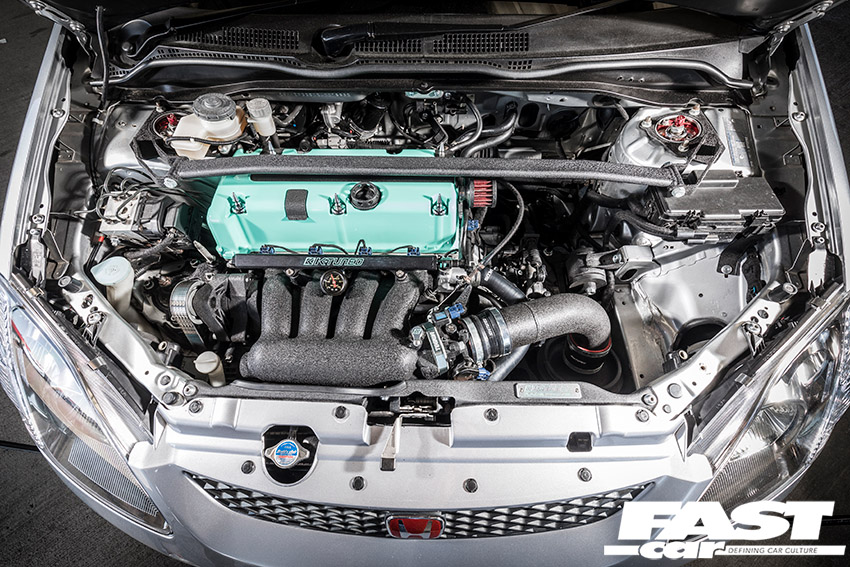
Honda Civic Type R EP3 Tuning Guide
Below, you’ll find we’ve focused on each area of the car, highlighting which areas you should consider upgrading, when you should do them and crucialy why. We’ll identify the weak areas on the car, and which areas are brilliant from factory. To skip to a specific area of tuning, be sure to use the jump links below.
Engine Tuning
Coming out of the factory with 197bhp, the K20 VTEC motor is one of the truly legendary Japanese powerplants. Equipped with dual-profile camshafts featuring the trick VTEC system, it offers drivers a unique Jeckyl and Hyde driving experience where below 5,800rpm it uses a low rpm profile that is relatively docile and economical but, breach that magic crossover point, and it switches to the high rpm performance profile where all hell breaks loose!
Some people love this dual personality. Others hate it. Nevertheless, it’s an attribute that certainly makes for an exciting drive, if you can live with the relative lack of low down grunt or simply enjoy revving the engine hard to extract the best performance.
The other issue with the Type R’s K20 engine being a highly-strung naturally aspirated motor is that power gains are not as easy to come by as a factory turbocharged car. This isn’t because the engine doesn’t take well to tuning, far from it, but with forced induction always being the place where big gains are found on any engine, you need to add the cost of converting the N/A engine to turbo or supercharged power into account if you are hoping for much over 300bhp.
Intake Tuning
As with any engine, extracting more performance means getting your motor breathing right, and with the K20, that means replacing the stock airbox with an induction kit. You can get small gains with a freer-flowing aftermarket drop-in filter, but ultimately you will need a complete induction kit to release the maximum performance. There are many options of induction kit on the market at wildly varying price points. As a rule of thumb though, especially with tuning parts, you do often get what you pay for, so do your research and don’t just go for the cheapest option.
We’d recommend either an Injen cold air intake for around £300 (which locates the filter down in the cool air behind the front bumper) or a Tegiwa carbon air box for £425 (which mounts near the stock location but uses a skuttle-mounted scoop to draw in cold air from the bonnet). If money is no object, a £830 Gruppe M ram air system (which is also a skuttle scoop design) is regarded as the best of the best. Expect to see a small improvement in response and power but a very noticeable gain in induction noise, especially when VTEC kicks in!
As well as an uprated induction kit, a larger diameter 70mm throttle body (from around £200) and matching uprated inlet manifold will also improve intake speed and volume, but can be quite costly. A popular and well-regarded inlet option is to run either an RBC or RRC inlet (priced from around £500), which are both OEM Honda parts, but have improved flow characteristics over the EP3’s UK-spec PRB item. However, they will need mild modifications to fit; something that many companies can do for you before purchase.
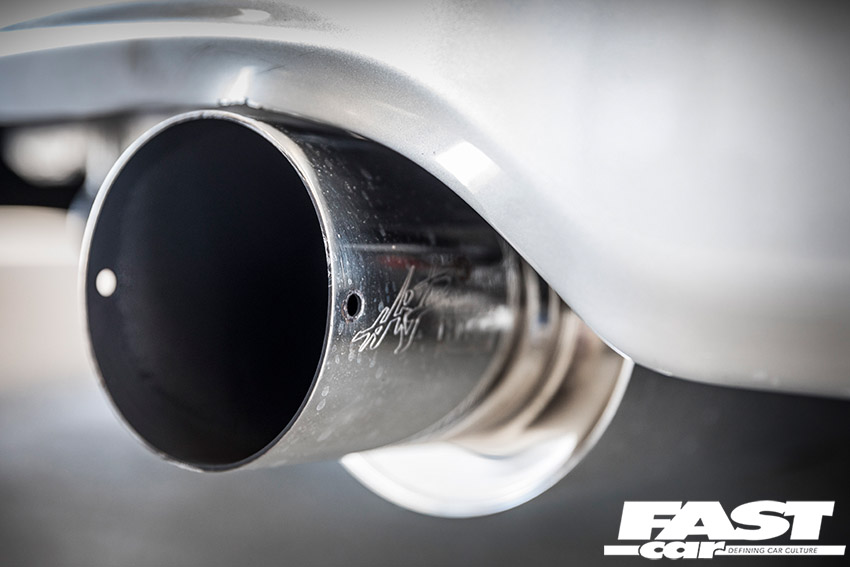
Exhaust Tuning
So now you’ve got more air coming into the engine, you need to get it out again and for that you need a freer-flowing exhaust system. The naturally aspirated K20 motor is especially receptive to exhaust tuning, but only by replacing the whole system including the manifold. The range of systems available are huge, as is the variation in price, so again it pays to do your research and not necessarily go for the cheapest one.
When it comes to the manifold, there are two basic designs – either 4-1 or 4-2-1. The 4-1 design offers more top-end gains and the 4-2-1 offers more mid-range performance. Prices range from around £350 for the Japspeed item, to over £1200 for the Toda Racing kit.
But whichever you choose, you’ll want to pair it with a 2.5in, or preferably 3in, exhaust system with either sports cat (around £500), or de-cat. Again, prices vary from around £550 for an off the shelf cat-back 2.5in system from the likes of Cobra Sport or Milltek, to over £600 for a fully bespoke custom 3in system from a company like Solid Fabrications. We’ve heard of gains of over 20bhp and 20lb ft from a full exhaust system, and it will complement future engine upgrades too.
Remapping
Once you have fitted your bolt-on modifications to the inlet and exhaust system you’ll need to have a suitable remap of the ECU to ensure safe running, and to extract the maximum potential from the setup. The most common way of doing this is with a Hondata ECU, a direct replacement for the standard unit, but far more suited to tuning. These start with the basic K100, which is available supplied and calibrated from around £750 to the more advanced KPro 4 coming in around £950. Once fitted, they can be custom remapped to suit any engine spec, even big bhp forced induction setups, and with the inlet and exhaust mods, should see around 240bhp, as well as good gains in midrange performance too and a lower VTEC engagement point, getting you onto that spicy cam profile sooner.

Further NA upgrades
Building on this spec, the next step would be to work on the head, although this will depend on how far you want to take naturally aspirated tuning. If around 250bhp is your end goal then a set of Skunk2 drop in cams (around £730) is an easy upgrade that will only need remapping to get to this level. However, beyond this, things get a lot more serious and expensive.
If sticking with the naturally aspirated route, further gains will come from either building the 2.0-litre into a high-compression screamer, or swapping the bottom end for a more torquey 2.4-litre unit from the K24 and retaining the K20 head – known as a Frankenstein build. Bang per buck, a Frank-build is your best bet as, not only will it likely work out a cheaper route to 270-280bhp, but it will also be more driveable with better low down and mid-range torque, and will also be less stressed and more reliable.
Forced induction
As ever, when it comes to big power, it’s hard to beat forced induction, and supercharging and turbocharging are both tried and tested options for the K20. Turbocharging gives the best overall power at the expense of throttle response. Alternatively, there are two different types of supercharger you could opt for. A positive displacement supercharger gives instant boost but is slightly limited on power, whereas a centrifugal supercharger is a happy medium between that and a turbo.
The general consensus is; although much more is possible, around 350bhp is the safe limit for long term reliability on stock internals, but this is easily gained on even the most basic of bolt-on supercharger and turbo conversions on the market from the likes of TTS Performance, CPL Racing, and TDI North. At around this level, the Jackson Racing supercharger is generally the most popular, simply as it gives the maximum drivability and fun, thanks to its ability to give full boost instantly.
If you want to go further, and if you feel capable of rebuilding the engine with forged internals, there is almost no limit. TTS sell Rotrex supercharger kits capable of in excess of 500bhp, and there are various turbo conversions available that push out in excess of 700bhp. In fact, it’s testament to how good the K20 engine is, that stock size head ports and the standard crankshaft can both handle well over 900bhp when turbocharged. Of course, this kind of power is only really any good in a drag car, but if you want it, it’s possible…
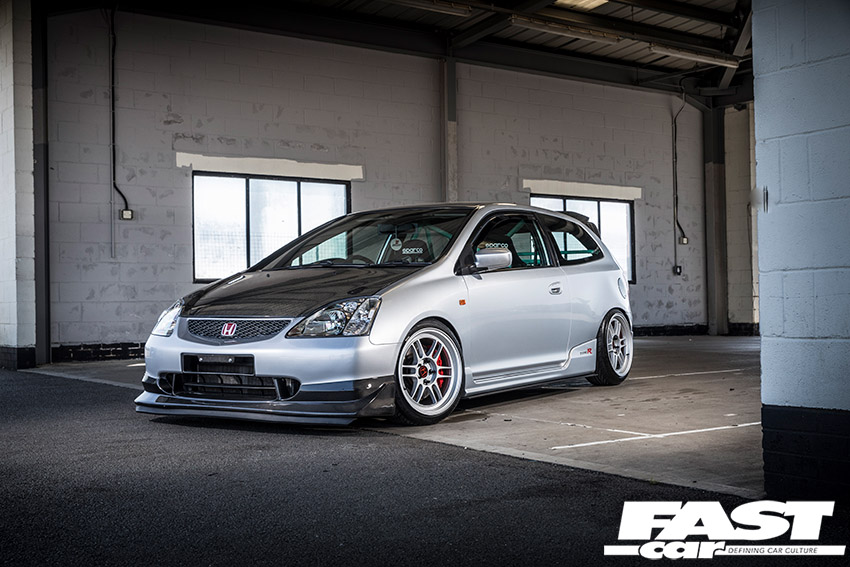
Honda Civic Type R Transmission Tuning & Upgrades
When it comes to the EP3’s transmission, its best to budget in replacement parts. While the motor is certainly capable of more power, the transmission isn’t, with the clutch being a particular weak area when upping power. Here’s what you need to consider when tuning.
Clutch upgrades
The EP3 stock six-speed transmission will cope with all but the highest power levels, but the stock clutch certainly won’t.
As most of these cars are getting on a bit now, even those with mild mods can see the clutch start to slip if its still on its original item, so it’s a good idea to budget for an upgraded clutch if you are planning upping the power. A typical Stage 2 kit from the likes of Action Clutch will cost around £540 will handle as much torque as you’re ever likely to see from naturally aspirated tuning, but supercharged and turbocharged cars might need to look to something with added bite such as a Stage 3 or 4 unit.
While you’re at it, it’s worthwhile upgrading the flywheel to a lightweight 3.2kg chromoly unit at the same time, as it only costs around £240 and perfectly fits the K20’s rev-happy nature.
Driveshafts
Honda driveshafts are sturdy units, but even these can break or wear out over time, especially with forced induction equipped cars pushing over twice the OEM power through them or under heavy track abuse. Upgrades for sub-250bhp cars are available for around £120 per side, but a pair of units capable of up to 500bhp will set you back around £700.
Gearsets
As we’ve already the mentioned, the EP3 has a great gearbox as standard, but you can still improve it. By swapping out the cogs for a close ratio set (from the likes of Spoon or MFactory), your Type R will accelerate quicker, although at the expense of a lower top speed. These are available from around £400, but installation will require a pricey gearbox rebuild. Although if money is no object, then Quaife’s QKE8J five-speed sequential gearbox will make your EP3 Civic Type R feel like a touring car when banging through the gears.
Differentials
Honda fitted the UK-spec EP3 Type R with a conventional open differential from the factory (the JDM models have a LSD as standard), so one of the best ways to improve the overall driving experience, even on a standard EP3, is to swap that for a limited-slip type differential.
Aggressive plate-type LSDs are available for racing applications, but most owners who predominantly drive their cars on the road prefer the torque-biasing types such as Quaife’s ATB, or the MFactory helical LSD. Prices range from around £600 to £750, plus fitting, but are a worthy upgrade and make a lot of sense when the gearbox is out for a clutch replacement/upgrade; adding one will transform the way your EP3 Type R handles.
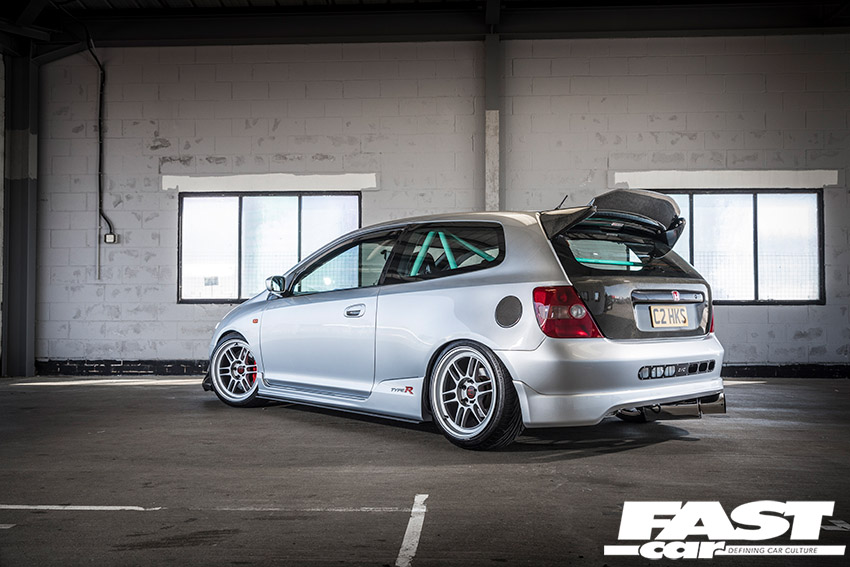
Honda Civic Type R EP3 Suspension Tuning
The EP3 has excellent suspension out of the box, producing an agile handling hatch that’s fun and playful. If you push it to the limit though, you’ll eventually overwhelm it, which is where uprated parts can help you out.
Springs and dampers
A set of uprated lowering springs is your cheapest options and will not only lower the ride height of your CTR, making it look better, but it will also lower the centre of gravity and stiffen the suspension too. This reduces roll and improves grip in the corners. Beyond this, a set of adjustable coilovers from the likes of BC Racing, Meister R or Bilstein are available from around £800 and will give you even more control, both over the ride height and the level of damping, allowing you to tailor the car’s handling to your own preference. Many quality kits also come with camber adjustable top mounts to help dial in the perfect alignment too.
Bushes
Most OEM cars come fitted with rubber bushes from the factory. These are cheap and replaceable, and are likely to have worn out by now, so swapping them for a firmer polyurethane upgrade makes a lot of sense. Not only do you get a genuine performance benefit of the stiffer bush and less unwanted flex in the suspension system, but they’ll never need replacing again in the future.
A full suspension bush kit from the likes of SuperPro or Polybush costs around £350, but you can upgrade individual areas one at a time, with prices ranging from £60 for front wishbone bushes.
Anti-roll bars
Anti-roll bars do exactly what they say on the tin – resist your car’s propensity to body roll. By fitting stiffer items you can increase their effect. For the EP3, you have two main options: the JDM spec ARBs are actually a big improvement, so these are a popular fit, and at around £100 each they are good value for money too. If you are looking to go a little more hardcore, Progress and Tanabe also make even stiffer versions for a little more money.
Geometry
Any performance car will benefit from a proper alignment of its suspension geometry and the EP3 Civic Type R is no different. But don’t just add it on at your local tyre fitters when you have your new tyres fitted, as their equipment is not really set up to get the best out of your modified ride. Your best bet is to go to a specialist who has the best equipment and knowledge to dial in custom camber, toe and caster settings to give you the handling you want from your car. To get the kind of camber you will want for a fast road or track setup, you will need some camber bolts from the likes of Eibach (£20). If you want the ultimate setup, get them to corner weight the car with you sat in the driver’s seat too.
Check out our wheel alignment guide for more geometry advice. Be sure to also check out our guide to the best suspension for the Honda Civic Type R.
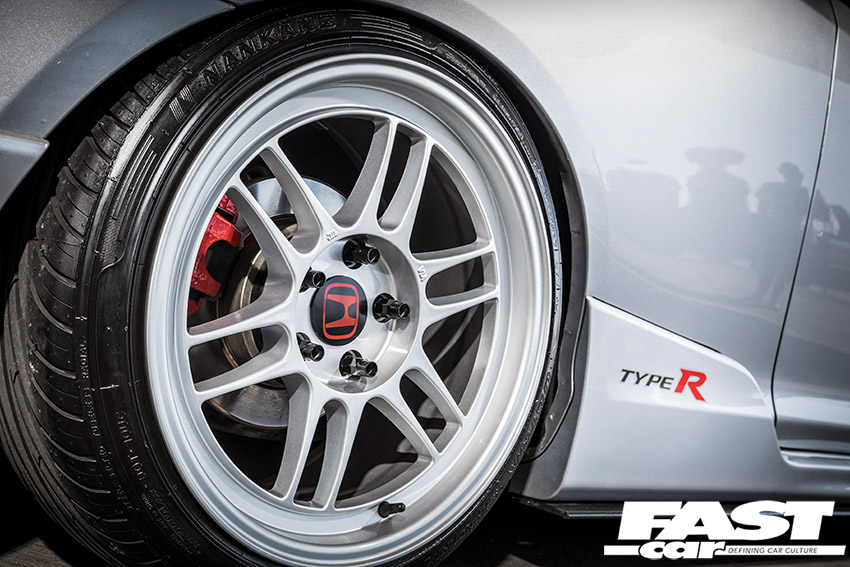
Honda Civic Type R EP3 Brake Tuning
The EP3 has decent enough brakes for stopping the standard 197bhp, but the factory 300mm discs, and sliding calipers with their raised ‘Type R’ lettering just don’t quite cut it when the power and therefore the speeds increase. Therefore, the first upgrade for most owners is a simple case of fitting some performance pads and discs from the likes of EBC.
But for those who use their Type R on track, or just want some more pose factor for the show ground, binning the single-piston sliders in favour of some big four or six-pots is the way to go. YellowSpeed’s big brake kit is a tried and tested option. It’ll cost you around £1500, but for the money you get 330mm discs and six-pot calipers. Alternatives include EBC’s new Apollo Balanced BBK, offering four-pot power with the added bonus of uprated pads for the rear too. If that doesn’t suffice, K-Sport, CompBrake, and Tarox all make EP3 brake kits for varying budgets.
Performance Wheels & Tires for the Honda Civic Type R EP3
The standard tires are normally 205/45/17s, and an upgrade to a 215 or 225 wide tire, often along with a profile drop to 40, gives a little more grip without needing to do any major arch work. With a high performance or track tire, you will get the bonus of a stiffer sidewall and a softer, stickier compound too. The CTR’s standard 17in alloy wheels are actually quite light, so there is no enormous need to change them. But, if you wish – especially when going for a 225 wide tire – you could fit 8x17s quite easily, as long as you stick to no lower than a ET35 offset. One thing to make sure of is that the replacement wheels are as light as you can realistically afford; heavy wheels will dampen all the good work you have done with your suspension upgrades.
Check out our best Honda Civic Type R wheels guide for some EP3 wheel inspiration.
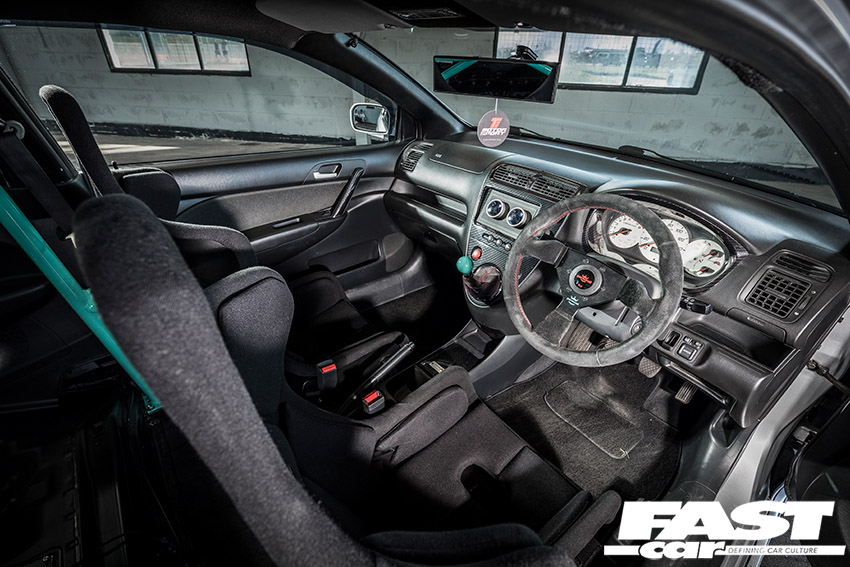
Honda Civic Type R Interior Modifications
The EP3 has a unique interior with cool red carpets and a funky dash-mounted gearshifter with a cool alloy gearknob, but the seats are not the best, especially when it comes to lateral loads when cornering hard. Luckily, replacements are aplenty with everything from flashy carbon-backed recliners to full-on BTCC-style wrap around buckets available from the likes of Recaro, Cobra and Corbeau.
But don’t forget to look within the Honda stable for alternatives too, as the Recaros from the DC5 are a popular option too, with even the awesome standard seats from the FK2 able to fit with a little modification to the rails. Other than that, you’ll be pretty much set with a nice retrim of the stock steering wheel or a racing replacement. Though, you could always rip it all out and go for a full race-spec roll cage of course…
Honda Civic Type R EP3 Styling Upgrades
There’s a big movement for people wanting their EP3 Type Rs to look as stock as possible, with only the most minor of styling tweaks, however, if you’re not one of them, feel free to go wild! Everything from subtle lip kits and spoilers to full-on wide arch kits and vented bonnets is available off the shelf, while you can rarely go wrong with swapping out metal parts and panels for lightweight carbon-fibre alternatives.
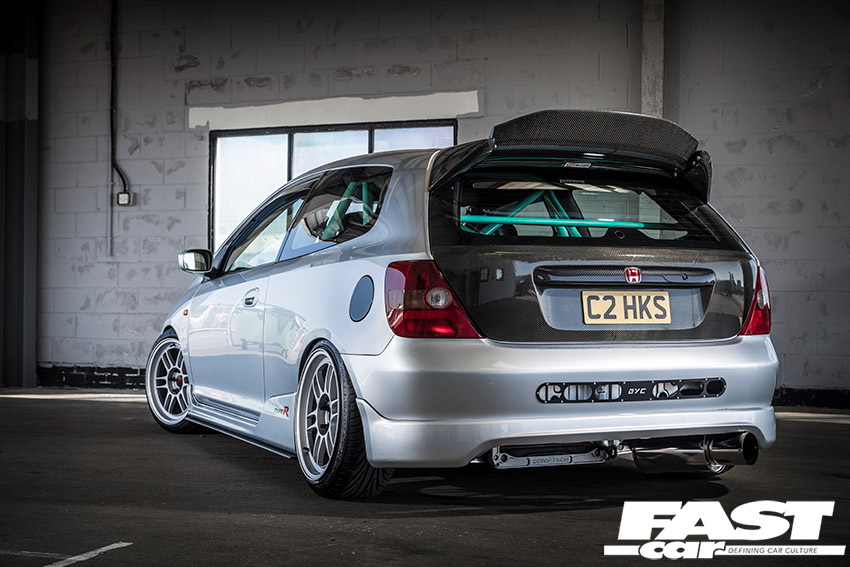
If you love Japanese cars then we’ve got the performance car shows for you. Be sure to check out our brand new Classic Japfest event, which is taking place at Goodwood circuit on October 6th. Brought to you by the same organisers of Japfest, it’s set to be a fantastic event filled with nostalgic Japanese icons.
The post Honda Civic Type R EP3 Tuning Guide appeared first on Fast Car.
Leia Mais.